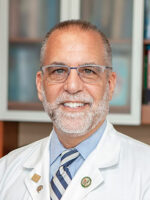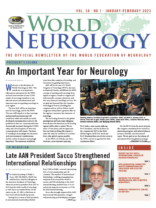By Orly Avitzur, MD, MBA, FAAN

Ralph L. Sacco, MD, MS, FAHA, FAAN
The untimely passing of Ralph L. Sacco, MD, MS, FAHA, FAAN, has saddened not only his colleagues at the American Academy of Neurology, where he served as president from 2017 to 2019, but the wider world of neurology as well. Sacco succumbed from a brain tumor on Jan. 17, 2023, at his home in New York with his family by his side.
During Sacco’s term as AAN president, its international membership climbed from 7,000 to 8,000—a record representing 21% of total membership and 141 countries. The number of International Scholarships, enabling young physician recipients from around the world to receive a $2,500 scholarship to the AAN Annual Meeting, doubled from 15 to 30 and set the stage for an increase to 35 for the 2020 Annual Meeting.
Sacco also strongly supported the AAN International Subcommittee, charged with promoting and developing strategies focusing on outreach and education for neurology in resource-limited countries or regions of the world to facilitate better care for patients with neurologic disease. The subcommittee continues to focus on meeting the needs of our global members, including improved access to membership benefits in low and low-middle income countries and supporting scholarships to the AAN Annual Meeting.
The opportunity to represent American neurology and the AAN to the international community delighted Sacco. He and Academy leadership attended the World Federation of Neurology’s 23rd World Congress of Neurology in September 2017 in Kyoto, Japan. Cohosted by the Japanese Society of Neurology and Asian and Oceanian Association of Neurology, the event’s theme was “Defining the Future of Neurology,” a topic of great interest to Sacco. He was the regional representative and the AAN’s delegate to the general assembly meeting, and chaired the North American Regional Symposium, which focused on prevention and treating common neurologic conditions. He spoke on treatment and prevention of stroke.
In December 2018, he and AAN CEO Catherine M. Rydell, CAE, traveled to Israel, where he gave presentations at the Israel Neurological Association (INA) annual meeting about the AAN and stroke, his specialty, and shared the stage with Dr. David Tanne, president of the INA; Natan Bornstein, past president of the INA; and Dr. Martin Dichgans, president of the European Stroke Organization. He also met with Israeli dignitaries, including the Israeli Minister of Health Rabbi Yaakov Litzman and president of the Israeli Medical Association Prof. Zion Hagay. He enjoyed touring Jerusalem’s Old City, Tel Aviv, and Jaffa.
“We traveled together to Santiago, Chile; Kyoto, Japan; Lisbon, Portugal; Tel Aviv, Israel; and Amsterdam, the Netherlands; among others,” said Rydell. “Ralph and I always felt so welcomed at each and every international society gathering including those hosted by the World Federation of Neurology, the European Academy of Neurology, and other international conferences and meetings that were so honored to have Ralph there to lecture and advise. It was a joy to see him interact with professionals who admired his intellect, his welcoming demeanor, and his one-of-a-kind Sacco smile.”
Sacco attended annual meetings of the Mexican Academy of Neurology, most recently in November 2021 as chair of the AAN Academic Neurology Committee, where he shared how the AAN is helping academic neurology in the U.S. meet a variety of challenges from revenue and funding issues to research and student recruitment.
In June 2019, Sacco was interviewed by AAN staff about the successes, challenges, and opportunities during his recently concluded term as president. He spoke with great joy and at length about the AAN’s relationship with the international neurology community and its leading organizations.
“Although we are the American Academy of Neurology, we do have an international mission, and that’s been important, and prior presidents have really helped push that. We recognize that we only have so much in terms of revenue and we probably can’t especially alone solve the problems, for example, in places like Africa, where there is just a totally insufficient number of neurologists to meet the demands.
“So, a lot of the things that we do to meet the demands and to help with international mission include collaborations. Part of it was working with important other organizations—the World Federation of Neurology, that really does have a truly global mission. We have developed a very close working relationship with the leaders of the World Federation of Neurology, contributing financially and contributing our ideas and thoughts to help with their mission. Working with the European Academy of Neurology, for example, in the course that’s provided particularly for training young members in African nations. We have a great relationship to the Mexican Academy of Neurology. I happened to go to their meetings and developed a close relationship with the Mexican Academy of Neurology.
“Because of some personal relationships, I got to go to the Pan Arab United Neurological Societies’ meeting in Jordan, and that was great to actually work with that group. Also, we were invited to go for the first time to the Israeli Neurological Association. Through this collaborative relationship-building with these other organizations, I think the Academy can help meet the needs of its international mission.
“We also further developed the International Subcommittee under Jerome Chin [Jerome H. Chin, MD, PhD, MPH, FAAN] which is a subcommittee of our Membership Engagement Committee. We expanded the number of international scholarships. When we give out money to bring young people from other nations to come to our Annual Meeting, that has an incredible impact on their career. I can’t tell you the number of people out there who say that that was life-changing for them when they attended the Academy of Neurology. So that was helpful to expand the number.
“We provide Continuum® free to many countries where they’re underserved or under-financed, and that has had a major impact on getting them exposed to a high-quality information to improve their careers. So, there are many, many ways that we work both with other organizations and within the Academy to expand our international mission.”
Sacco was the chairman of neurology; Olemberg Family Chair in Neurological Disorders; Miller Professor of Neurology Public Health Sciences, Human Genetics, and Neurosurgery; executive director of the Evelyn McKnight Brain Institute; senior associate dean for Clinical and Translational Science, University of Miami, Miller School of Medicine; and chief of the neurology service at Jackson Memorial Hospital.
A graduate of Cornell University and a cum laude graduate of Boston University School of Medicine, Sacco received a master’s in epidemiology from Columbia University, School of Public Health. He completed his neurology residency training and postdoctoral training in stroke and epidemiology at Columbia Presbyterian in New York. He was previously professor of neurology, chief of Stroke and Critical Care Division, and associate chairman at Columbia University before taking his most recent position in 2007.
Sacco was an international expert in stroke epidemiology and health disparities. He was the founding principal investigator of the Northern Manhattan Study, the Florida Puerto Rico Collaboration to Reduce Stroke Disparities, and the Miami Clinical Translational Science Institute, as well as co-investigator of multiple other NIH grants. Sacco published extensively with over 1,000 peer-reviewed articles (h-index 109) in the areas of stroke prevention, treatment, epidemiology, risk factors, vascular cognitive impairment, human genetics, and outcomes and has been listed as a Web of Science Highly Cited Researcher since 2017.
He was the recipient of numerous awards, including the AAN Wartenberg Lecture, AHA Feinberg Award of Excellence in Clinical Stroke, the WSO Global Stroke Leadership Award, AHA Gold Heart Award, the NINDS Javits Award in neuroscience, and numerous named lectures.
Sacco was a fellow of both the Stroke and Epidemiology Councils of the American Heart Association, a fellow of the ANA, and an elected member of the Association of American Physicians and National Academy of Medicine. He was the first neurologist to serve as the president of the American Heart Association from 2010 to 2011.
Visit AAN.com/Sacco to learn more about this giant of neurology and to leave memories. •
